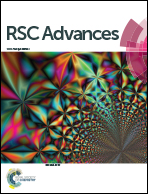Flexible Janus nanofibers: a feasible route to realize simultaneously tuned magnetism and enhanced color-tunable luminescence bifunctionality†
Abstract
Novel magnetic-fluorescent bifunctional Janus nanofibers with high luminescent intensity and tunable luminescence color have been successfully fabricated by electrospinning technology using a specially designed parallel spinneret. The Janus nanofiber is composed of Fe3O4/polyvinyl pyrrolidone (PVP) as one strand of the nanofiber and [Dy(BA)3phen + Eu(BA)3phen]/PVP as the other strand of the nanofiber. The morphology and properties of the final products have been investigated in detail by X-ray diffractometry (XRD), scanning electron microscopy (SEM), energy dispersive spectrometry (EDS), transmission electron microscopy (TEM), vibrating sample magnetometry (VSM) and photoluminescence (PL) spectroscopy. The results reveal that the Janus nanofibers possess superior magnetic and luminescence properties due to their special nanostructure. Tunable colors from greenish blue to white to yellowish pink can be realized in the flexible Janus nanofibers by varying the mass ratio of Dy(BA)3phen to Eu(BA)3phen, and furthermore, it is the first time that white-light-emitting flexible Janus nanofibers have been achieved using rare earth complexes as luminescent centers. The impact of different amounts of Fe3O4 nanoparticles on the luminescence color and intensity of the Janus nanofibers is in-depth investigated. The new type of magnetic and color-tunable bifunctional Janus nanofibers have potential applications in the fields of bio-medicine, nanotechnology, and color displays, etc. due to their excellent magnetic-fluorescent properties, tunable color and flexibility.


 Please wait while we load your content...
Please wait while we load your content...